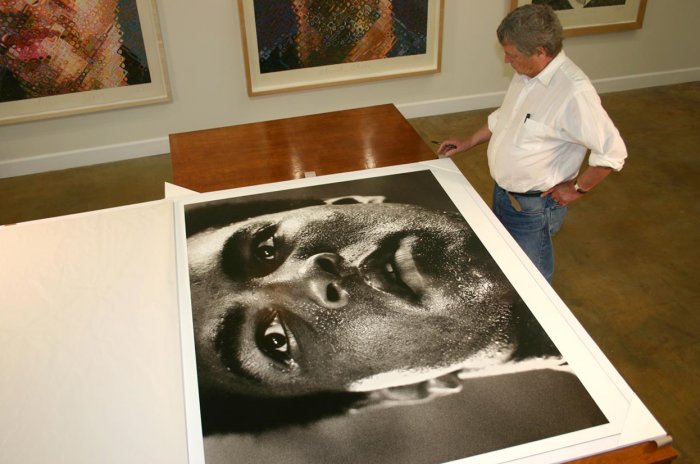“As his ‘minder’ I was often dispatched by the editor to convince the usually drunk Behan to return to the office to write his column. On one such occasion Brendan informed me that he would only return if I, at the tender and illegal drinking age of fifteen join him in a drink. I can honestly boast that my first time drunk was the fault of Brendan Behan.”
Brennan learned what he calls the “then well respected trade of newspaper photography” after
Taking a job with South London’s Croydon Times. One of Brennan’s neighbors growing had been George Phillips, a photographer who influenced Michael and who gave him tips on photography. Although Brennan owned a Yashica-Mat, a compact crank advance camera, most of the work he did for the Croydon Times involved taking group shots with an extremely heavy glass plate camera. “Fifty years later, I can say without equivocation that I gained nothing except a stiff neck from using those contraptions,” he comments.
Learning the ropes as a photographer, there were some memorable mishaps. “My first week,” recalls Brennan, “I had to do a group shot of a Catholic diocese.” While trying to get all his subjects into the frame Brennan told the head priest “Get a little closer to your wife.”
Brennan’s career took off in the early 60s when he worked in Manchester, which he remembers as being the “Las Vegas of Britain.” On January 4, 1967 he took a series of terrifying photographs of the Englishman Donald Campbell crashing and dying while attempting the world water speed record on Lake Coniston. Brennan’s photos, which appeared in Life Magazine, won him the prestigious British News Picture of the Year award.
After returning to London in 1969 Brennan worked for Rupert Murdoch’s Sun newspaper. In his first year with the Sun he was awarded British photography’s highest accolade “Photographer of the Year,” which was presented to him by Princess Anne. With celebrity culture “not yet on the horizon” Brennan’s pictures from that era covered serious topics including the emerging troubles in Northern Ireland, The Indo-Pakistani War and other international skirmishes.
After the Daily Mail assigned him to New York in 1973 Brennan began a more than 30 year stint in New York, also shooting photos for Sports Illustrated. When Brennan spent time in Pennsylvania covering Muhammad Ali’s training sessions, the champ took a liking to Brennan, giving him unprecedented access. “His generosity knew no boundaries,” says Brennan, “His humor, friendship and goodwill are legendary.” His legendary portrait of Muhammad Ali entitled “1977” found a permanent home at the National Portrait Gallery, Smithsonian Institute in 2011 and was included in a group exhibition there later that year.
In addition to his iconic portraits of Muhammad Ali, Brennan has photographed some of the best-known personalities of our time, including Her Majesty Queen Elizabeth II, Nelson Mandela, Princess Diana, Pele, George Best, Mick Jagger, John Lennon and literary figures including Norman Mailer and P.G. Wodehouse.
Now retired in Costa Rica, Michael Brennan says self-deprecatingly that he was “reasonably good at what he did.” Looking back, he sees the 60s and 70s as a “fun period” before paparazzi took over photo journalism. For Brennan photography wasn’t just about who was being photographed: it was about the atmosphere. His great photo of Muhammad Ali is about much more than the man: it was also about the sweat covering his face and the far seeing look in his eyes.
“Michael Brennan’s iconic 1977 portrait photograph of Muhammad Ali captures something far bigger and deeper than just the beautiful face of a beautiful man. It is a detailed map of the personal journey of one whose incomparable talents and audacity caused literati to swoon, taught a generation to question authority, and ultimately altered the path of a society which had never before seen a man exactly like him. For tens of millions of us born as baby boomers, the gradual dissolution of the power portrayed in those features has both embodied and reflected the gradual dissolution of our youth. To look at him the way he was then is to remember, with joy and sorrow, who we all once were.”
Jim Lampley
Boxing commentator, HBO Sports
Although Brennan says that he regrets that “great photojournalism has been violated by the celebrity culture that is now lumped in with the same,” he notes with optimism that “There were, and still are, great artists who carry on the tradition of wonderful photography and ply their trade for newspapers and magazines.”
Without a doubt, Michael Brennan is one of those greats himself.

Michael Brennan signing the monumental photograph entitled “I977”
|